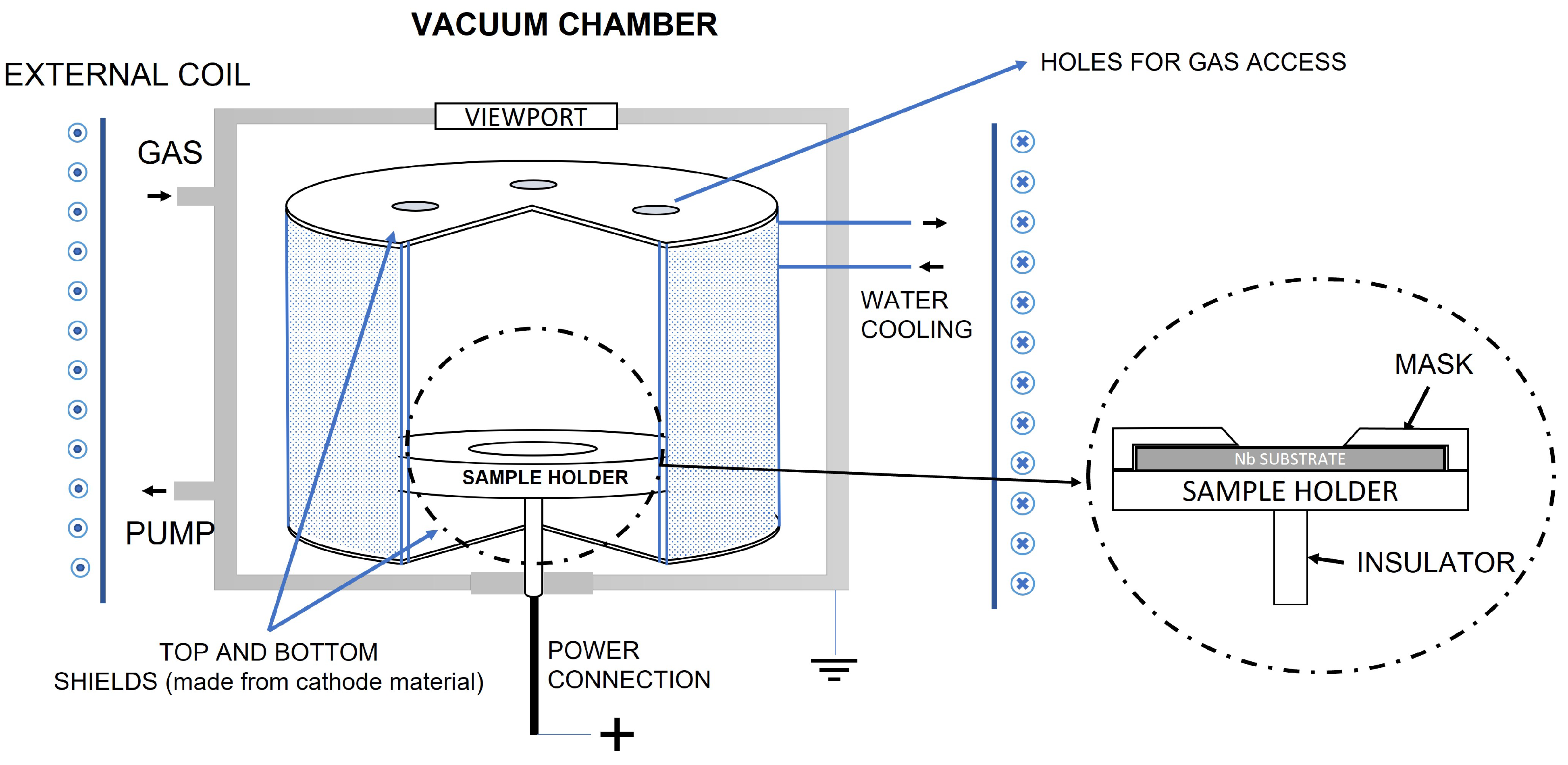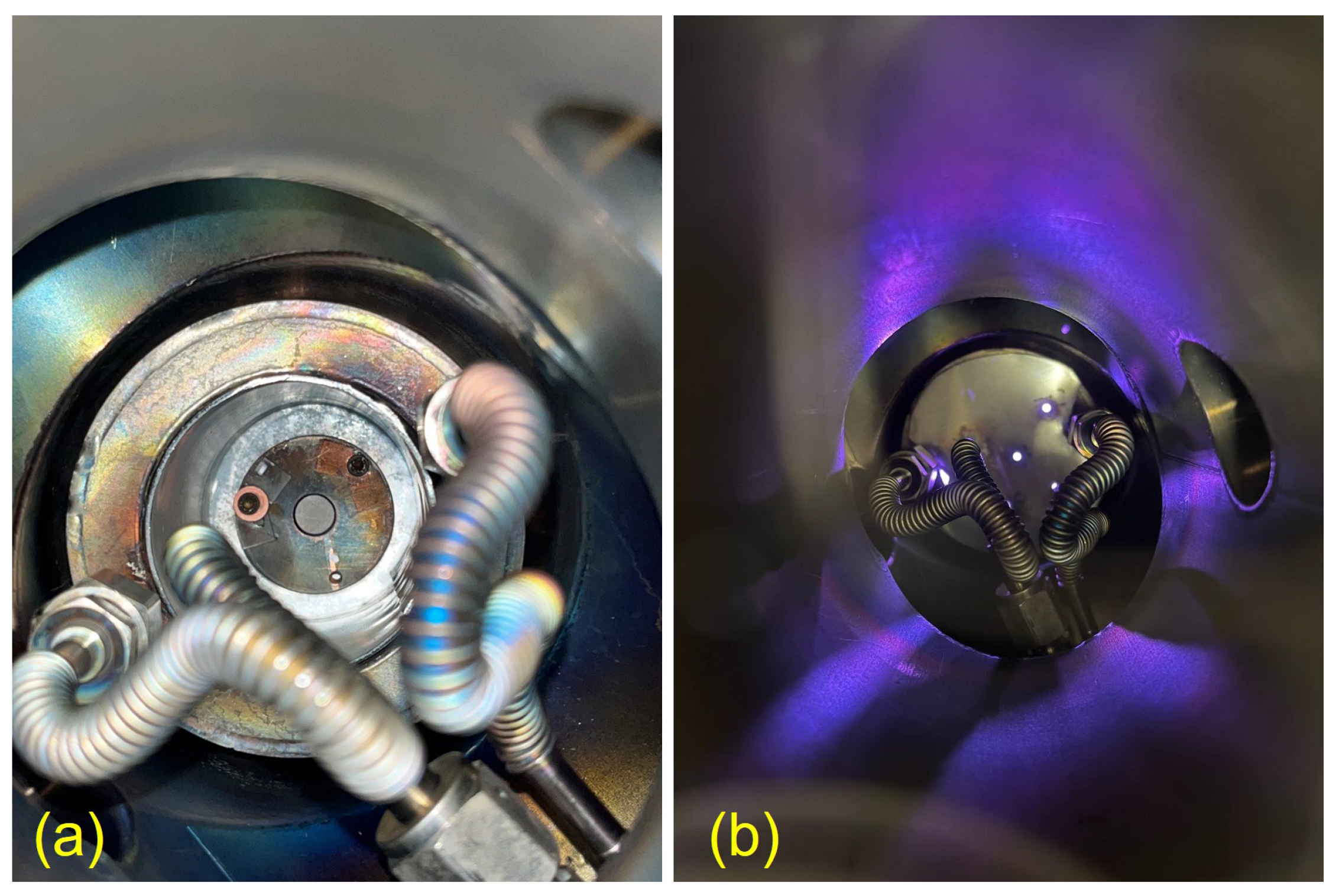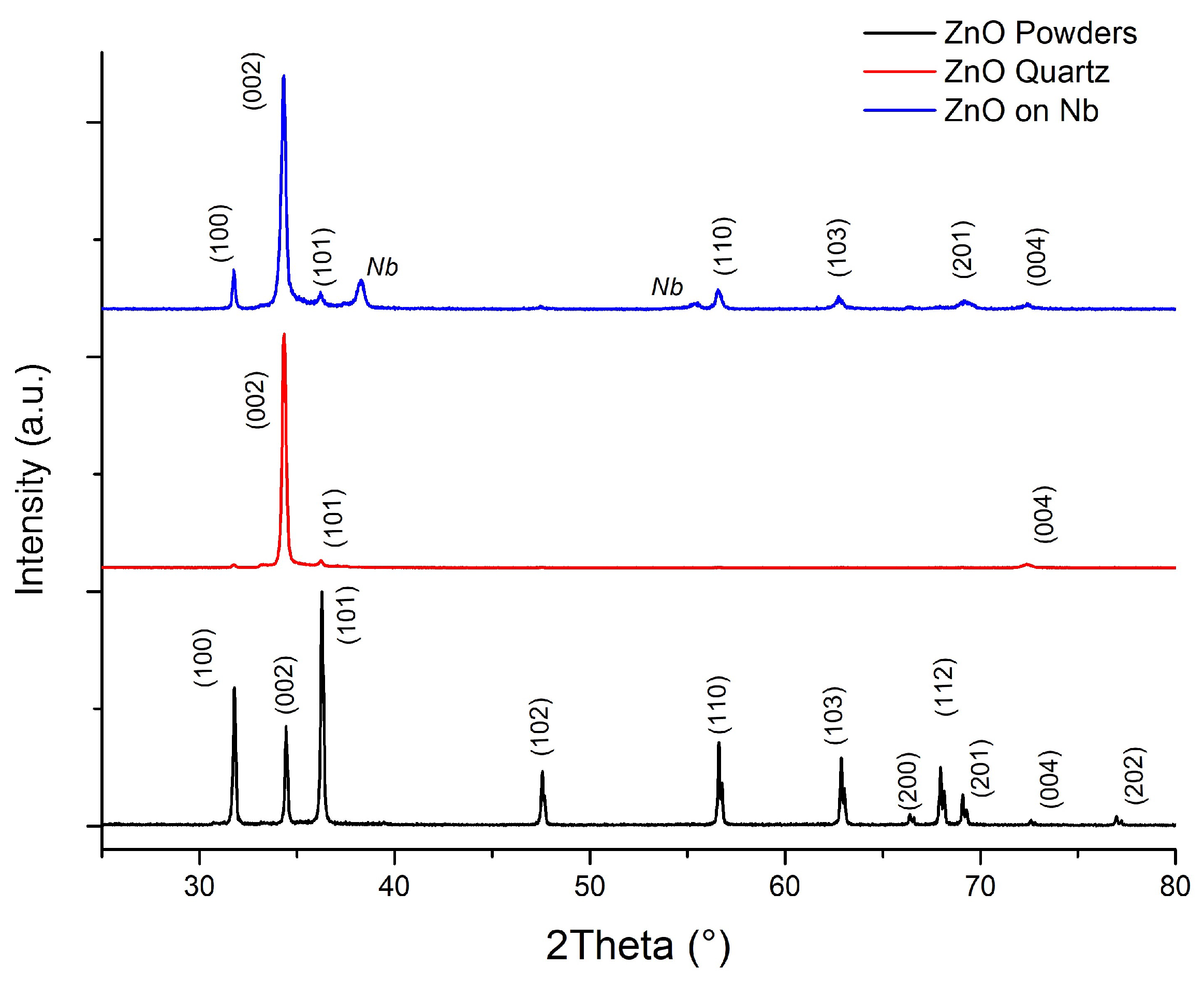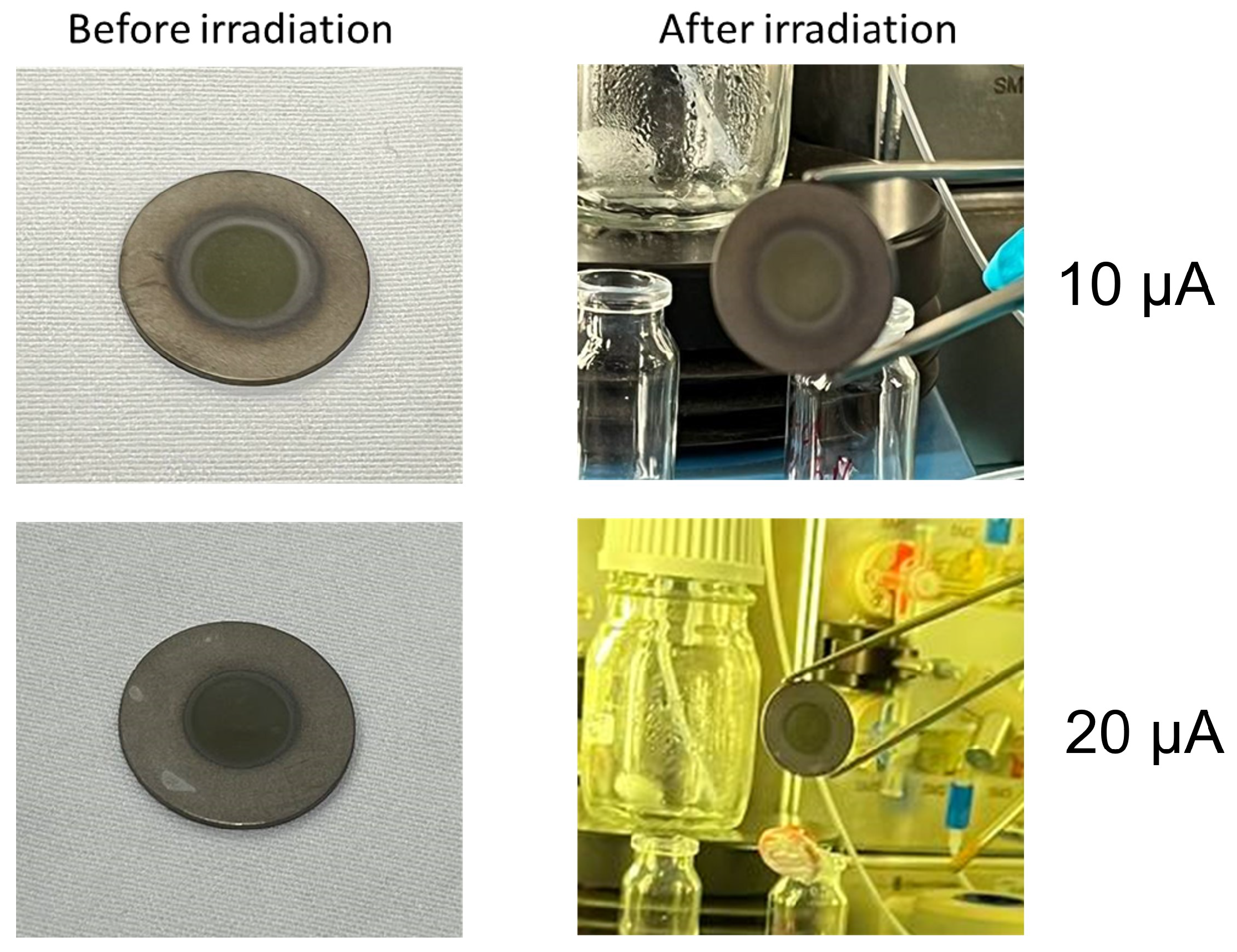First Results on Zinc Oxide Thick Film Deposition by Inverted Magnetron Sputtering for Cyclotron Solid Targets Production
Abstract
:1. Introduction
2. Materials and Methods
2.1. Brief Description of Inverted Magnetron Source
- ultrasound bath with distilled water with the addition of 5 mL of Rodaclean® (NGL Cleaning Technology SA, Nyon, Switzerland) soap for 20 min at 40 °C;
- ultrasound bath with distilled water for 20 min;
- rinsing with ethanol 96% and drying with the gas gun (oil-free compression system).
2.2. Sputtering System
2.3. Characterisations
2.4. Cyclotron Irradiation
3. Results
3.1. Deposition Parameters and Setup Optimisation
3.2. Morphology, Growing Behaviour, and Deposition Rate
3.3. Compound Evaluation
3.4. Cyclotron Irradiation Tests
4. Discussion
4.1. IM Sputtering Process
4.2. Material-Saving Approach
4.3. Targets Manufacturing
5. Conclusions
Author Contributions
Funding
Institutional Review Board Statement
Informed Consent Statement
Data Availability Statement
Acknowledgments
Conflicts of Interest
References
- Rebelo, R.; Calderon, S.; Fangueiro, R.; Henriques, M.; Carvalho, S. Influence of oxygen content on the antibacterial effect of Ag-O coatings deposited by magnetron sputtering. Surf. Coatings Technol. 2016, 305, 1–10. [Google Scholar] [CrossRef]
- Echavarría, A.M.; Calderón, J.A.; Bejarano, G. Microstructural and electrochemical properties of TiAlN (Ag, Cu) nanocomposite coatings for medical applications deposited by dc magnetron sputtering. J. Alloys Compd. 2020, 828, 154396. [Google Scholar]
- Skliarova, H.; Azzolini, O.; Cherenkova-Dousset, O.; Johnson, R.; Palmieri, V. Niobium-based sputtered thin films for corrosion protection of proton-irradiated liquid water targets for [18F] production. J. Phys. D Appl. Phys. 2013, 47, 045306. [Google Scholar] [CrossRef]
- Palmieri, V.; Azzolini, O.; Bemporad, E.; Felicis, D.D.; Johnson, R.R.; Renzelli, M.; Skliarova, H. Influence of the microstructure on the diffusion barrier performance of Nb-based coatings for cyclotron targets. J. Vac. Sci. Technol. A Vac. Surf. Film. 2019, 37, 051510. [Google Scholar] [CrossRef]
- Queern, S.L.; Aweda, T.A.; Massicano, A.V.F.; Clanton, N.A.; El Sayed, R.; Sader, J.A.; Zyuzin, A.; Lapi, S.E. Production of Zr-89 using sputtered yttrium coin targets. Nucl. Med. Biol. 2017, 50, 11–16. [Google Scholar] [CrossRef] [PubMed]
- Skliarova, H.; Cisternino, S.; Cicoria, G.; Marengo, M.; Cazzola, E.; Gorgoni, G.; Palmieri, V. Medical Cyclotron Solid Target Preparation by Ultrathick Film Magnetron Sputtering Deposition. Instruments 2019, 3, 21. [Google Scholar] [CrossRef]
- Kotliarenko, A.; Azzolini, O.; Keppel, G.; Pira, C.; Esposito, J. Investigation of a Possible Material-Saving Approach of Sputtering Techniques for Radiopharmaceutical Target Production. Appl. Sci. 2021, 11, 9219. [Google Scholar] [CrossRef]
- George, K.; Borjian, S.; Cross, M.; Hicks, J.; Schaffer, P.; Kovacs, M. Expanding the PET radioisotope universe utilizing solid targets on small medical cyclotrons. RSC Adv. 2021, 11, 31098–31123. [Google Scholar] [CrossRef]
- Stolarz, A. Target preparation for research with charged projectiles. J. Radioanal. Nucl. Chem. 2014, 299, 913–931. [Google Scholar] [CrossRef]
- Cisternino, S.; Cazzola, E.; Skliarova, H.; Amico, J.; Malachini, M.; Gorgoni, G.; Anselmi-Tamburini, U.; Esposito, J. Target manufacturing by spark plasma sintering for efficient 89Zr production. Nucl. Med. Biol. 2022, 104, 38–46. [Google Scholar] [CrossRef]
- Esposito, J.; Bettoni, D.; Boschi, A.; Calderolla, M.; Cisternino, S.; Fiorentini, G.; Keppel, G.; Martini, P.; Maggiore, M.; Mou, L.; et al. LARAMED: A laboratory for radioisotopes of medical interest. Molecules 2018, 24, 20. [Google Scholar] [CrossRef] [PubMed]
- Thornton, J.A. Magnetron sputtering: Basic physics and application to cylindrical magnetrons. J. Vac. Sci. Technol. 1978, 15, 171–177. [Google Scholar] [CrossRef]
- Geerk, J.; Linker, G.; Meyer, O. HTSC thin film growth by inverted cylindrical magnetron sputtering. J. Supercond. 1992, 5, 345–351. [Google Scholar] [CrossRef]
- Duarte, D.; Massi, M.; da Silva Sobrinho, A.; Maciel, H.; Grigorov, K.; Fontana, L. Titanium dioxide thin films deposition by direct current hollow cathode magnetron sputtering. Eur. Phys. J.-Appl. Phys. 2010, 49, 13107. [Google Scholar] [CrossRef]
- Lecoq, E.; Guillot, J.; Duday, D.; Chemin, J.B.; Choquet, P. Elaboration of a wide range of TiO2 micro/nanostructures by high power impulse inverted cylindrical magnetron sputtering. J. Phys. D Appl. Phys. 2014, 47, 195201. [Google Scholar] [CrossRef]
- De Nardo, L.; Pupillo, G.; Mou, L.; Esposito, J.; Rosato, A.; Meléndez-Alafort, L. A feasibility study of the therapeutic application of a mixture of 67/64Cu radioisotopes produced by cyclotrons with proton irradiation. Med. Phys. 2022, 49, 2709–2724. [Google Scholar] [CrossRef]
- Mou, L.; Martini, P.; Pupillo, G.; Cieszykowska, I.; Cutler, C.S.; Mikołajczak, R. 67Cu production capabilities: A mini review. Molecules 2022, 27, 1501. [Google Scholar] [CrossRef]
- Brühlmann, S.A.; Walther, M.; Kreller, M.; Reissig, F.; Pietzsch, H.J.; Kniess, T.; Kopka, K. Cyclotron-Based Production of 67Cu for Radionuclide Theranostics via the 70Zn (p, α) 67Cu Reaction. Pharmaceuticals 2023, 16, 314. [Google Scholar] [CrossRef]
- Dave, P.Y.; Patel, K.H.; Chauhan, K.V.; Chawla, A.K.; Rawal, S.K. Examination of zinc oxide films prepared by magnetron sputtering. Procedia Technol. 2016, 23, 328–335. [Google Scholar] [CrossRef]
- Mazur, M.; Obstarczyk, A.; Posadowski, W.; Domaradzki, J.; Kiełczawa, S.; Wiatrowski, A.; Wojcieszak, D.; Kalisz, M.; Grobelny, M.; Szmidt, J. Investigation of the Microstructure, Optical, Electrical and Nanomechanical Properties of ZnOx Thin Films Deposited by Magnetron Sputtering. Materials 2022, 15, 6551. [Google Scholar] [CrossRef]
- Ellmer, K.; Welzel, T. Reactive magnetron sputtering of transparent conductive oxide thin films: Role of energetic particle (ion) bombardment. J. Mater. Res. 2012, 27, 765–779. [Google Scholar] [CrossRef]
- Kwoka, M.; Lyson-Sypien, B.; Kulis, A.; Maslyk, M.; Borysiewicz, M.A.; Kaminska, E.; Szuber, J. Surface properties of nanostructured, porous ZnO thin films prepared by direct current reactive magnetron sputtering. Materials 2018, 11, 131. [Google Scholar] [CrossRef] [PubMed]
- Dang, W.; Fu, Y.Q.; Luo, J.; Flewitt, A.; Milne, W. Deposition and characterization of sputtered ZnO films. Superlattices Microstruct. 2007, 42, 89–93. [Google Scholar] [CrossRef]
- Gao, W.; Li, Z. ZnO thin films produced by magnetron sputtering. Ceram. Int. 2004, 30, 1155–1159. [Google Scholar] [CrossRef]
- Kandpal, K.; Singh, J.; Gupta, N.; Shekhar, C. Effect of thickness on the properties of ZnO thin films prepared by reactive RF sputtering. J. Mater. Sci. Mater. Electron. 2018, 29, 14501–14507. [Google Scholar] [CrossRef]
- Menon, R.; Gupta, V.; Tan, H.; Sreenivas, K.; Jagadish, C. Origin of stress in radio frequency magnetron sputtered zinc oxide thin films. J. Appl. Phys. 2011, 109, 064905. [Google Scholar] [CrossRef]
- Jazmati, A.K.; Abdallah, B. Optical and structural study of ZnO thin films deposited by RF magnetron sputtering at different thicknesses: A comparison with single crystal. Mater. Res. 2018, 21, e20170821. [Google Scholar] [CrossRef]
- Rahmane, S.; Aida, M.S.; Djouadi, M.A.; Barreau, N. Effects of thickness variation on properties of ZnO: Al thin films grown by RF magnetron sputtering deposition. Superlattices Microstruct. 2015, 79, 148–155. [Google Scholar] [CrossRef]
- Skliarova, H.; Cisternino, S.; Cicoria, G.; Cazzola, E.; Gorgoni, G.; Marengo, M.; Esposito, J. Cyclotron solid targets preparation for medical radionuclides production in the framework of LARAMED project. In Proceedings of the Journal of Physics: Conference Series, 10th Young Researcher Meeting, Rome, Italy, 18–21 June 2019; IOP Publishing: Bristol, UK, 2020; Volume 1548, p. 012022. [Google Scholar]
- Degen, T.; Sadki, M.; Bron, E.; König, U.; Nénert, G. The HighScore suite. Powder Diffr. 2014, 29, S13–S18. [Google Scholar] [CrossRef]
- Escudero, R.; Escamilla, R. Ferromagnetic behavior of high-purity ZnO nanoparticles. Solid State Commun. 2011, 151, 97–101. [Google Scholar] [CrossRef]
- Wang, Z.; Chu, J.; Zhu, H.; Sun, Z.; Chen, Y.; Huang, S. Growth of ZnO: Al films by RF sputtering at room temperature for solar cell applications. Solid-State Electron. 2009, 53, 1149–1153. [Google Scholar] [CrossRef]
- Li, Z.; Gao, W. ZnO thin films with DC and RF reactive sputtering. Mater. Lett. 2004, 58, 1363–1370. [Google Scholar] [CrossRef]
- Scherrer, P. Nachr Ges wiss goettingen. Math. Phys. 1918, 2, 98–100. [Google Scholar]
- Stein, H.; Naujoks, D.; Grochla, D.; Khare, C.; Gutkowski, R.; Grützke, S.; Schuhmann, W.; Ludwig, A. A structure zone diagram obtained by simultaneous deposition on a novel step heater: A case study for Cu2O thin films. Phys. Status Solidi (a) 2015, 212, 2798–2804. [Google Scholar] [CrossRef]
- Skliarova, H.; Cisternino, S.; Cicoria, G.; Marengo, M.; Palmieri, V. Innovative Target for Production of Technetium-99m by Biomedical Cyclotron. Molecules 2018, 24, 25. [Google Scholar] [CrossRef] [PubMed]
- Panjan, P.; Drnovšek, A.; Gselman, P.; Čekada, M.; Panjan, M. Review of growth defects in thin films prepared by PVD techniques. Coatings 2020, 10, 447. [Google Scholar] [CrossRef]






| Experiment Number | Sputtering Voltage [V] | Time [min] | Thickness [m] | M [ mg] | Density * [%] | Substrate |
|---|---|---|---|---|---|---|
| Exp 8 | 460 | 115 | 15 | - | - | /Quartz |
| Target 1 | 500 | 130 | 20 | 6.34 | 4.1 | coin |
| Target 2 | 550 | 150 | 30 | 9.17 | 3.9 | coin |
Disclaimer/Publisher’s Note: The statements, opinions and data contained in all publications are solely those of the individual author(s) and contributor(s) and not of MDPI and/or the editor(s). MDPI and/or the editor(s) disclaim responsibility for any injury to people or property resulting from any ideas, methods, instructions or products referred to in the content. |
© 2023 by the authors. Licensee MDPI, Basel, Switzerland. This article is an open access article distributed under the terms and conditions of the Creative Commons Attribution (CC BY) license (https://creativecommons.org/licenses/by/4.0/).
Share and Cite
Kotliarenko, A.; Azzolini, O.; Cisternino, S.; El Idrissi, M.; Esposito, J.; Keppel, G.; Pira, C.; Taibi, A. First Results on Zinc Oxide Thick Film Deposition by Inverted Magnetron Sputtering for Cyclotron Solid Targets Production. Materials 2023, 16, 3810. https://doi.org/10.3390/ma16103810
Kotliarenko A, Azzolini O, Cisternino S, El Idrissi M, Esposito J, Keppel G, Pira C, Taibi A. First Results on Zinc Oxide Thick Film Deposition by Inverted Magnetron Sputtering for Cyclotron Solid Targets Production. Materials. 2023; 16(10):3810. https://doi.org/10.3390/ma16103810
Chicago/Turabian StyleKotliarenko, Alisa, Oscar Azzolini, Sara Cisternino, Mourad El Idrissi, Juan Esposito, Giorgio Keppel, Cristian Pira, and Angelo Taibi. 2023. "First Results on Zinc Oxide Thick Film Deposition by Inverted Magnetron Sputtering for Cyclotron Solid Targets Production" Materials 16, no. 10: 3810. https://doi.org/10.3390/ma16103810





